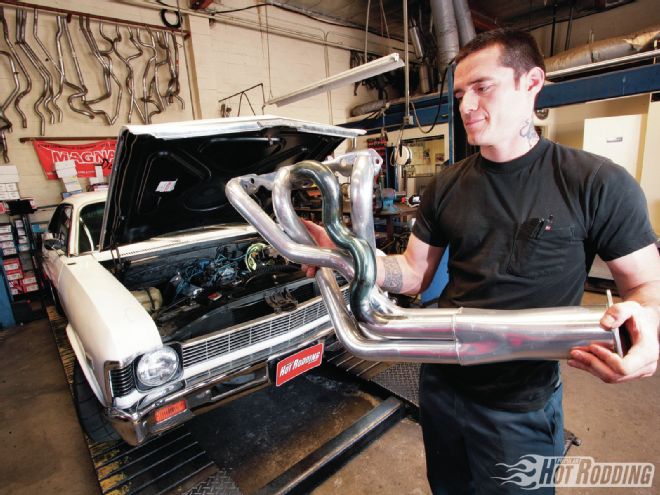
In a perfect world, headers would always fit, and a lot of times they do. But building a hot rod means by definition that you’re changing or modifying the stock parts with stuff that doesn’t always occupy the same space as the original equipment. Header manufacturers try their best to anticipate typical hot rod moves—like big oil pans, cylinder heads with elevated exhaust ports, better steering boxes, high-torque starters, or custom steering shafts—but there are just too many possibilities that must be covered. We found ourselves in a similar situation with our 1968 Chevy Nova project car, and decided to deal with the problem head-on.
After ordering a set of Hooker Super Comp long-tube headers, we discovered that one of the primary tubes interfered with our new CPP steering box. In previous situations, we’ve gotten out the dead-blow hammer and fired up the acetylene torch and dimpled the pipe to affect the necessary clearance. This time, however, the tube made a head-on collision. (Note: had we read the fine print in the Hooker catalog, we could’ve avoided the problem altogether, but we decided to forge ahead rather than return the headers and try re-ordering a different set.)
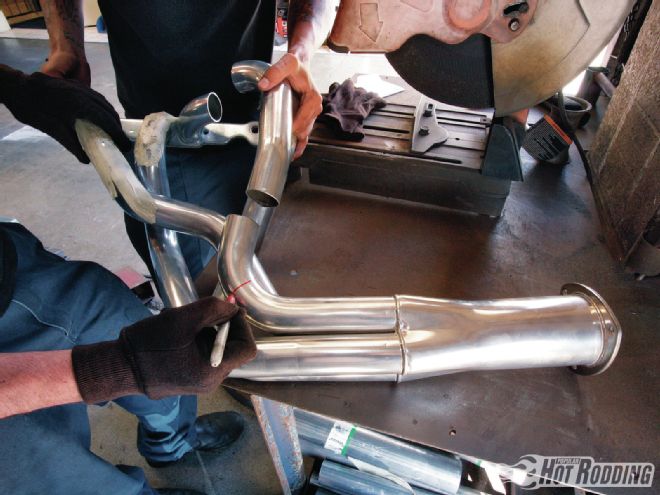 The outermost primary on the driver side of our Hooker Super Comp headers (PN 2207-1HKR, 17/8-inch diameter primaries) was cut out using a 14-inch chop saw. This allowed us to get the header mounted on the ’68 Nova so Automotive Excellence could finish the Flowmaster exhaust.
The outermost primary on the driver side of our Hooker Super Comp headers (PN 2207-1HKR, 17/8-inch diameter primaries) was cut out using a 14-inch chop saw. This allowed us to get the header mounted on the ’68 Nova so Automotive Excellence could finish the Flowmaster exhaust.
Since our Nova was already at Automotive Excellence, one of Southern California’s best exhaust shops (Huntington Beach, California), we had the confidence in them to cut out the offending header primary tube, build out the rest of the exhaust system (see “Piping Up,” Oct. ’11), fabricate a different primary tube around the steering box, then have the driver-side header ceramic coated. Shop owner Alex Mayea and AE technician Tony Andrade made it look easy, thanks to some really cool pieces from Hooker, and that’s what we’re here to tell you about.
Hooker’s alignment weld sleeves are designed to hold sections of header tubing together while you figure out your geometry. Two (or many more) sections of pipe—either straight or radiused—can be butted together and rotated, thanks to the alignment sleeves, which hold them together with tension. This is not one of those deals you’ve seen where you mock-up a tinker-toy apparatus, then have to duplicate your creation. The Hooker alignment sleeves allow you to easily play with the actual sections of pipe you’ll use, without going through the frustration of holding, tacking, breaking, holding (again!), then re-tacking welds in tricky, hard-to-reach places. The sleeves are really easy to use, and allow the DIY guy to create the trickiest, tightest compound curves in his own garage.
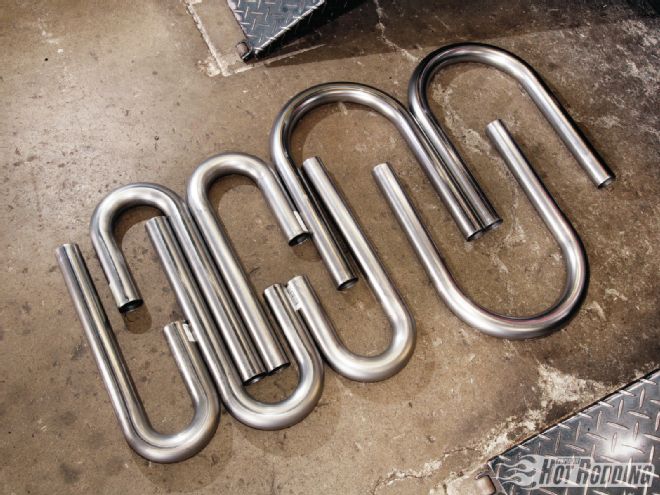 We kind of went overboard ordering mandrel-bent 17/8-inch diameter J-bends. In the end, we only needed one of each—a 2½-inch and a 6-inch radius. And we still had pipe leftover from both of those.
We kind of went overboard ordering mandrel-bent 17/8-inch diameter J-bends. In the end, we only needed one of each—a 2½-inch and a 6-inch radius. And we still had pipe leftover from both of those.
The alignment sleeves are made of mild steel, and feature an exposed pinch in the middle. The pinch is your filler when it’s time to tack, then completely weld your finished work. The sleeve section on the inside of the pipe also eliminates pinhole leaks and reduces the potential for blow-through while welding. Hooker’s alignment weld sleeves are made in five sizes (1½ to 15/8 inches, 1¾ inches, 17/8 inches, 2 inches, and 21/8 inches) and come in packs of 20 for around $25.
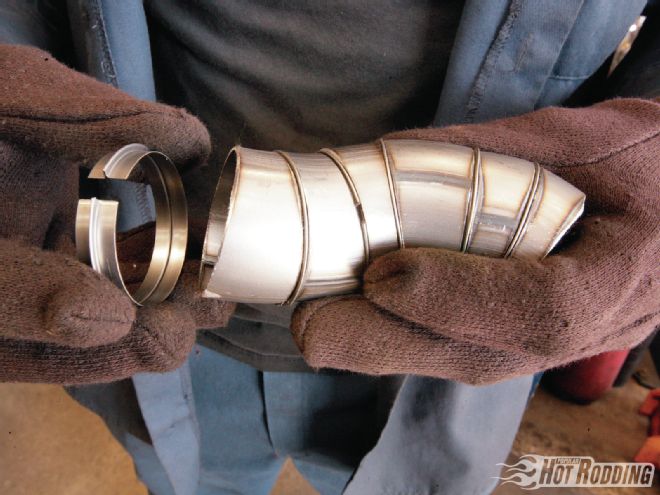 The Hooker alignment weld sleeves not only keep the pipes centered, they’re spring loaded to help keep them together while you snake your assembly through the engine bay.
The Hooker alignment weld sleeves not only keep the pipes centered, they’re spring loaded to help keep them together while you snake your assembly through the engine bay.
Of course, you can reuse your original primary tube for the reroute job, but we found it easier to start out with fresh mandrel-bent radiused tubing, which Hooker also sells by the pipe. We ended up using two different J-pipes of 17/8-inch diameter (about $18 each)—one in a 2½-inch radius, and the other in a 6-inch radius. When cut up into a variety of section lengths and wedges, we found these to be more than adequate to do our single header pipe.
While working with Hooker’s weld alignment sleeves, we began to appreciate the fact that it would be possible to build a completely custom set of headers using these. A more likely scenario would be to buy a set of headers that closely resembles what you want, then fab the rest using mandrel-bent tubing and alignment sleeves for the tube (or tubes) that need rerouting. This would give you something close to a custom header for near the price of an off-the-shelf item. We’re glad we tried them—they will remain a go-to option for us in the future!
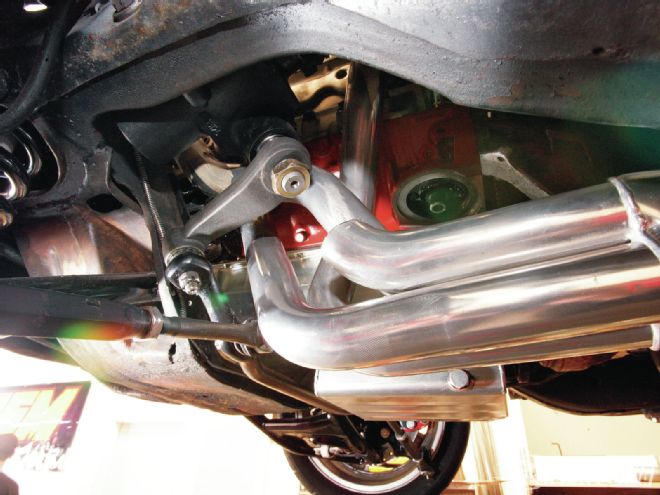 Once back on the car, the AE crew could see how dramatic the header pipe interference was with our new steering box and raised-port cylinder heads. At this point, it looked nearly impossible to do the work-around.
Once back on the car, the AE crew could see how dramatic the header pipe interference was with our new steering box and raised-port cylinder heads. At this point, it looked nearly impossible to do the work-around.
Where The Money Went
Description: Source: PN: Cost: Weld alignment sleeves, 1 7/8-inch dia. Hooker/Summit 12103HKR $24.95 (package 20) J-bend, 1 7/8-inch dia., 6-inch radius Hooker/Summit 12560HKR $17.95 (each) J-bend, 1 7/8 -inch dia., 2½-inch radius Hooker/Summit 12558HKR $17.95 (each)